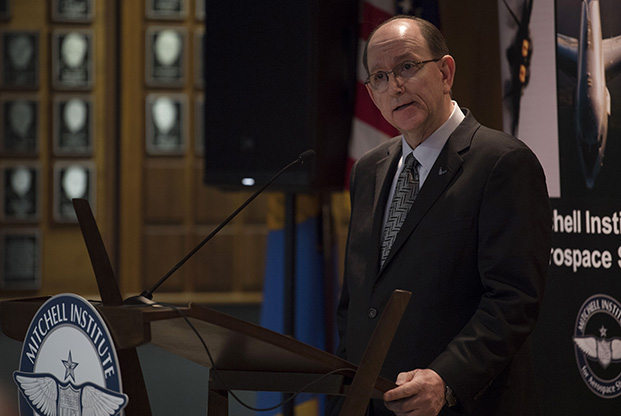
Speaking to reporters after a AFA Mitchell Institute event on Jan. 18, 2019, ?Air Force ?Undersecretary Matt Donovan said a light attack RFP isn't on the way "anytime soon." Mitchell Institute photo.
The Air Force won’t be issuing a request for proposals for a new light attack aircraft as expected, and will in fact expand its “campaign” of experiments to include larger and more powerful aircraft, possibly including jets, Undersecretary Matt Donovan said Friday.
Speaking to reporters after an AFA Mitchell Institute event in Arlington, Va., Donovan said a light attack aircraft request for proposals—which was expected by the end of 2018—won’t be coming “anytime soon” and that procurement funding for the program won’t be included in the forthcoming FY 2020 budget.
Pressed for an explanation, Donovan said “what you would expect to see is a continuation of the experimentation campaign” with light attack in fiscal 2019. Further experiments, he said, will provide “insight” on “all manner of things, not only cost,” but, “Did we meet the cost targets that we were aiming for?” Other questions to be answered are, “What’s the market out there for our coalition partners? Do we have lots of folks that are interested in that or is there something else?”
Asked if USAF will look at aircraft besides the two finalists in the light strike evaluations—Textron’s AT-6 Wolverine and Sierra Nevada/Embraer’s A-29 Super Tucano—Donovan said the field of candidates will “expand out a little bit.” Does that mean more powerful airplanes? “It could be,” he said, adding USAF wants to “broaden the scope a bit. … We’re not excluding anything.” Asked specifically if the Boeing T-X might be considered, he nodded and said, “It could.”
The Air Force has said all along that it has two main goals for its light strike exploration. The first is to operate in permissive airspace with a light aircraft that would be far less costly to operate than a fast jet. The second is to partner with host nations fighting terrorists and insurgencies using a common, less expensive, and less complex airplane that more countries could afford. Countries rarely buy an airplane not in the US arsenal, however, because they want the lower costs that come with economies of scale and the assurance that the US will continue to be a customer for support and parts for many years to come.
Donovan’s comments suggest that candidate partners were not necessarily keen to operate a light turboprop and wanted something more capable. They also suggest that the operating costs of the light strike aircraft evaluated were perhaps not as low as had been expected.
Aircraft such as Boeing’s T-X and Lockheed Martin/Korean Aerospace Industries’ T-50 candidate for the advanced trainer program were specifically ruled out in the latter part of USAF’s light strike experimentation program. Seemingly, they are once again possibilities, as would be aircraft like Textron’s company-funded Scorpion light jet, which was suggested as a potential T-X contender early in its development but not officially offered. Scorpion also was previously ruled out for the light attack aircraft program.